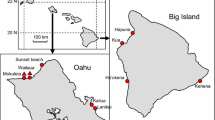Abstract
The relationship between environmental factors and the spatial distribution of maintained and actively used burrows of the grapsid crab Helograpsus haswellianus was studied at three saltmarsh sites in southeast Queensland, Australia. The sites had been modified by runnelling for mosquito-control, a method that transports low-amplitude tides to areas of saltmarsh. The study investigated the relationship between burrow density, burrow aperture size, and runnelling, as well as the effect of flooding or non-flooding tides and distance from a tidal source. Responses differed at the three sites. The most consistent pattern across all sites was that active burrows were most numerous between 30 and 50 m from the saltmarsh/mangrove interface at the landward side of the tidal source. At particular sites, there were significant relationships between burrow aperture size, tidal period, and the presence of runnels. Generally, few small burrows occurred low on the shore, while larger burrows were distributed across the shore to 50 m. At naturally dry sites, more burrows occurred within 5 m of the runnel, whereas at naturally wet sites, fewer burrows were found close to the runnel. As runnels transport low-amplitude tides moisture conditions required for burrowing may very between flooding and non-flooding tides. Overall, the influence of tides on the density of crab burrows and their aperture sizes was of more importance than the presence of runnels alone.
Similar content being viewed by others
Literature Cited
Breitfuss, M. J. 2003. Defining the characteristics of burrows to better estimate abundance of the grapsid crab, Helograpsus haswellianus (Decapoda, Grapsidae), in an Australian saltmarsh. Crustaceana 76:499–507.
Breitfuss, M. J. and R. M. Connolly. 2004. Consolidation and water content of coastal saltmarsh substrates following mosquito control habitat modification. Wetlands Ecology and Management (in press).
Breitfuss, M. J., R. M. Connolly, and P. E. R. Dale. 2003. Mangrove distribution and mosquito control: transport of Avicennia marina propagules by mosquito control runnels in southeast Queensland saltmarshes. Estuarine Coastal and Shelf Science 56:573–579.
Chapman, H. F., P. E. R. Dale, and B. H. Kay. 1998. A method for assessing the effects of runneling on salt marsh grapsid crab populations. Journal of the American Mosquito Control Association 14:61–68.
Dale, P. E. R., A. L. Chandica, and M. Evans. 1996. Using image subtraction and classification to evaluate change in subtropical intertidal wetlands. International Journal of Remote Sensing 17:703–719.
Dale, P. E. R. and M. B. Dale. 2002. Optimal classification to describe environmental change: pictures from the exposition. Community Ecology 3:19–29.
Dunham, D. W. and S. L. Gilchrist. 1988. Behaviour. p. 97–138. In W. W. Burggren and B. R. McMahon (eds.) Biology of the Land Crabs. Cambridge University Press, Cambridge, UK.
Fielder, D. R. and J. G. Greenwood. 1984. The complete larval development of Helograpsus haswellianus (Whitelegge) (Decapoda, Grapsidae), reared in the laboratory. Proceedings of the Royal Society of Queensland 95:11–22.
Griffin, D.. 1966. The taxonomy, ecology and social behaviour of the Tasmanian shore crabs (Crustacea, Brachyura) of the families Grapsidae and Ocypodidae. Ph.D. Dissertation. University of Tasmania, Tasmania, Australia.
Griffin, D. 1971. The ecological distribution of grapsid and ocypodid crabs (Crustacea: Brachyura) in Tasmania. Journal of Animal Ecology 40:597–621.
Higginbottom, K. B. 1982. Behavioural ecology of the mud crab Helograpsus haswellianus: agonistic behaviour and burrows. Honours Thesis. University of Adelaide, Adelaide, Australia.
Hulsman, K., P. E. R. Dale, and B. H. Kay. 1989. The runnelling method of habitat modification: an environment-focussed tool for salt marsh mosquito management. Journal of the American Mosquito Control Association 5:226–234.
Marsh, J., 1982. Aspects of the ecology of three saltmarshes of the Derwent region, and an investigation into the role of the burrowing crab Helograpsus haswellianus (Whitelegge, 1889). Honours Thesis. University of Tasmania, Tasmania Australia.
McKillup, S. and A. Butler. 1979. Cessation of hole-digging by the crab Helograpsus haswellianus: Resource-conserving adaptation. Marine Biology 50:157–161.
Morrisey, D., T. H. De Witt, D. Roper, and R. Williamson. 1999. Variation in the depth and morphology of burrows of the mud crab Helice crassa among different types of intertidal sediments in New Zealand. Marine Ecology Progress Series 182:231–242.
Queensland Department of Transport. 2001 The Official Tide Tables and Boating Safety Guide 2001. Queensland Department of Transport. Brisbane, Australia.
Richardson, A. M. M., R. Swain, and V. Wong. 1997. The crustacean and molluscan fauna of Tasmanian saltmarshes. Proceedings of the Royal Society of Tasmania 131:21–30.
Richardson, A. M. M., R. Swain, and V. Wong. 1998. Relationship between the crustacean and molluscan assemblages of Tasmanian saltmarshes and the vegetation and soil conditions. Marine and Freshwater Research 49:785–799.
Schubart, C. D., J. A. Cuesta, and D. L. Felder. 2002. Glyptograpsidae, a new brachyuran family from Central America: larval and adult morphology, and a molecular physlogeny of the grapsoidae. Journal of Crustacean Biology 22:28–44.
Skilleter, G. and S. Warren. 2000. Effects of habitat modification in mangroves on the structure of mollusc and crab assemblages. Journal of Experimental Marine Biology and Ecology 244:107–129.
Snelling, B. 1959. The distribution of intertidal crabs in the Brisbane River. Australian Journal of Marine and Freshwater Research 10: 67–83.
Williamson, R. B., R. J. Wilcock, B. E. Wise, and S. E. Pickmere. 1999. Effect of burrowing by the crab Helice crassa on chemistry of intertidal muddy substrates. Environmental Toxicology and Chemistry 18:2078–2086.
Author information
Authors and Affiliations
Rights and permissions
About this article
Cite this article
Breitfuss, M.J., Connolly, R.M. & Dale, P.E.R. Densities and aperture sizes of burrows constructed by Helograpsus haswellianus (decapoda: varunidae) in saltmarshes with and without mosquito-control runnels. Wetlands 24, 14–22 (2004). https://doi.org/10.1672/0277-5212(2004)024[0014:DAASOB]2.0.CO;2
Received:
Revised:
Accepted:
Issue Date:
DOI: https://doi.org/10.1672/0277-5212(2004)024[0014:DAASOB]2.0.CO;2




